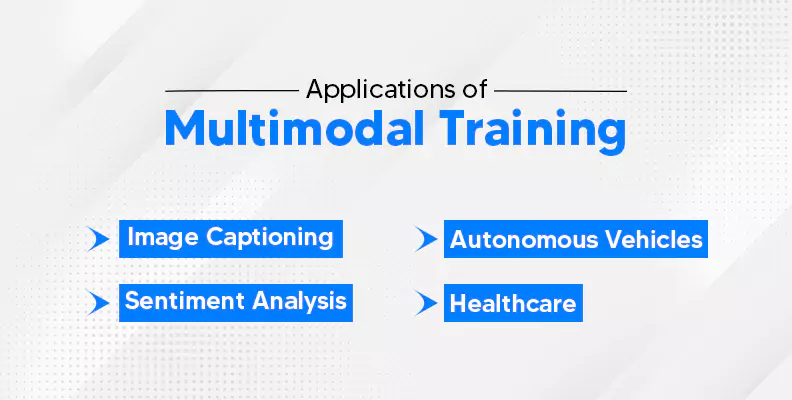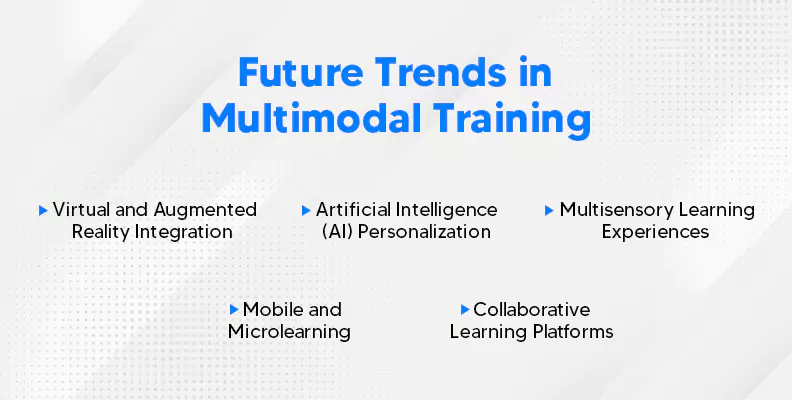Loading.....
Power of Multimodal Training in Machine Learning
In the ever-evolving landscape of machine learning, researchers and practitioners constantly push the boundaries of what's possible. One of the most promising and impactful advancements in recent years is multimodal training. This paradigm shift involves training models to process and understand information from multiple modalities, such as text, images, and audio, simultaneously. This approach not only mirrors the way humans perceive and comprehend the world but also opens up new avenues for solving complex problems. In this blog, we'll explore the concept of multimodal training, its applications, and the challenges and opportunities it presents.

Multimodal Training Definition
Traditionally, machine learning models have been developed to specialize in a single modality, be it natural language processing, computer vision, or audio analysis. However, the world is inherently multimodal, and information is often conveyed through a combination of text, images, and sound. Multimodal training seeks to bridge these modalities, allowing models to learn and generalize across diverse data types.
A key aspect of multimodal training is the incorporation of different neural networks tailored for each modality. These networks are interconnected, enabling the model to capture intricate relationships and dependencies between modalities. For instance, a multimodal model could simultaneously analyze an image and its corresponding textual description, learning the nuanced connections between visual and linguistic information.
Applications of Multimodal Training

- Image Captioning: Multimodal training has proven instrumental in tasks like image captioning. Models trained on both images and corresponding textual descriptions can generate accurate and contextually relevant captions for images. This application finds use in areas such as content creation, accessibility for visually impaired individuals, and automated image indexing.
- Sentiment Analysis: Combining textual data with audio or visual cues allows for more nuanced sentiment analysis. For instance, understanding the sentiment behind a spoken phrase might require considering both the spoken words and the speaker's facial expressions. Multimodal models can capture these subtleties, leading to more accurate sentiment predictions.
- Autonomous Vehicles: In the realm of autonomous vehicles, multimodal training is pivotal. Models need to process information from various sensors, including cameras, lidar, and microphones. Integrating these modalities enables the development of robust systems capable of making informed decisions based on a holistic understanding of the environment.
- Healthcare: Multimodal training has promising applications in healthcare, where patient data often includes a combination of medical images, textual records, and even voice data. Models trained to analyze these multimodal datasets can assist in diagnosis, treatment planning, and patient monitoring.
Challenges and Opportunities
While multimodal training presents exciting possibilities, it also comes with its set of challenges. One primary concern is the increased complexity of models and the need for substantial computational resources. Integrating multiple modalities requires larger datasets and more sophisticated architectures, often demanding powerful hardware.
Additionally, creating balanced multimodal datasets can be challenging, as each modality may have different levels of inherent noise or bias. Ensuring that the model doesn't favor one modality over the others is crucial for achieving true multimodal understanding.
However, the challenges are accompanied by significant opportunities. Multimodal training allows models to leverage the strengths of each modality, compensating for the weaknesses of individual modalities. This not only enhances performance but also promotes more robust and interpretable models.
Future Trends in Multimodal Training
As technology continues to evolve, several trends are shaping the future landscape of multimodal training, transforming the way individuals acquire and retain knowledge.

-
Virtual and Augmented Reality Integration
One of the most notable trends in multimodal training is the increasing integration of virtual and augmented reality (VR/AR) technologies. These immersive experiences enhance training programs by simulating real-world scenarios, providing learners with a more engaging and practical learning environment. From medical simulations to hands-on technical skills development, VR and AR are set to revolutionize the training landscape. -
Artificial Intelligence (AI) Personalization
AI is playing an increasingly prominent role in customizing training experiences. Adaptive learning platforms use AI algorithms to analyze individual learning styles, preferences, and progress, tailoring content delivery accordingly. This personalization not only accelerates the learning process but also ensures that training is optimized for each learner, maximizing effectiveness. -
Multisensory Learning Experiences
The future of multimodal training involves the integration of multiple senses to enhance the learning experience. Beyond traditional visual and auditory stimuli, advancements in haptic technology allow learners to interact physically with digital content. This multisensory approach promotes a deeper understanding and retention of information, making training more effective and memorable. -
Mobile and Microlearning
With the increasing prevalence of mobile devices, training is becoming more accessible and flexible. Microlearning, which delivers content in small, digestible units, is gaining popularity. Mobile-compatible multimodal training allows learners to access information on-the-go, promoting continuous learning and enabling organizations to adapt to the fast-paced nature of modern work environments. -
Collaborative Learning Platforms
Collaboration is a key component of effective training, and future trends in multimodal training emphasize the importance of collaborative learning platforms. Virtual classrooms, discussion forums, and interactive group activities facilitate knowledge-sharing and peer-to-peer learning. This approach not only enhances engagement but also mirrors the collaborative nature of many professional settings.
Conclusion
Multimodal training represents a pivotal shift in the landscape of machine learning, allowing models to comprehend and interpret information from diverse sources simultaneously. From image captioning to healthcare applications, the potential uses are vast and transformative. While challenges exist, ongoing research and advancements in hardware capabilities are paving the way for more sophisticated and efficient multimodal models. As we navigate this exciting frontier, the fusion of modalities in machine learning is bound to redefine the limits of what AI systems can achieve, bringing us closer to machines that can truly understand the complexity of the human experience.
 Back to blog
Back to blog












